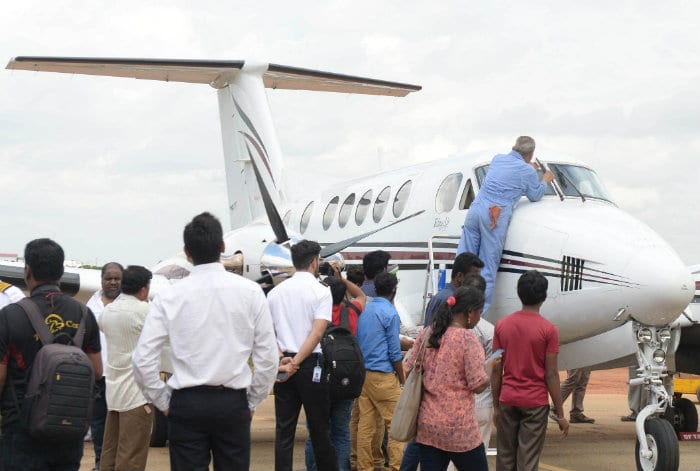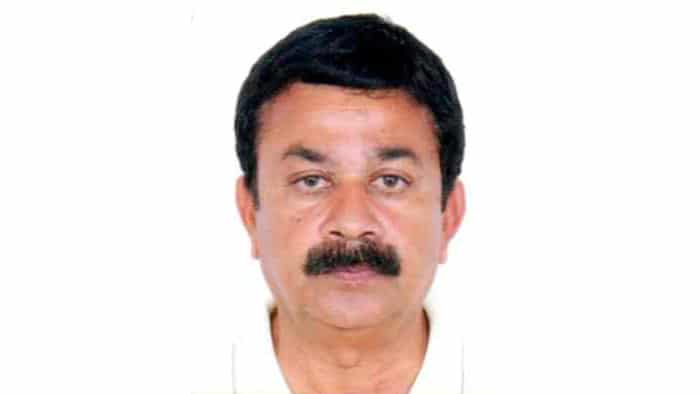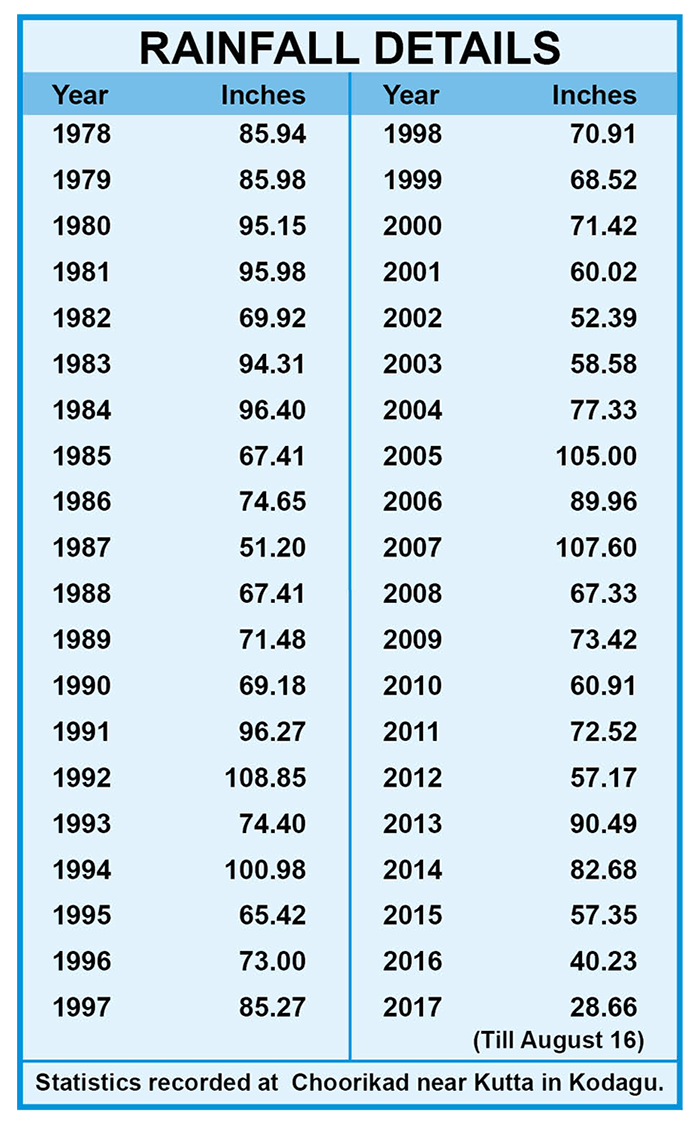By Nataraj Kallichanda
Owing to deficient rainfall, the State government has launched cloud-seeding at an estimated cost of Rs. 35 crore, for 60 days. Cloud-seeding will be done across three river basins — Cauvery, Malaprabha and Tungabhadra.
The State government has described the cloud-seeding experiment as “essential” and that it would be taken up in places where it was required. However, many meteorologists have warned that
cloud-seeding is a costly experiment with no guarantee of rains. There have been three experiments in Karnataka since the 1970s and the record has been patchy, say experts.

The flight for cloud seeding – BQ-100 Beechcraft – is being readied for cloud-seeding project Varshadhari, in Bengaluru yesterday. The flight did a one-hour sortie and sprayed Silver Iodide, Sodium Chloride and Potassium Chloride into clouds to condense water particles to produce rains.
Being a resident of South Kodagu, I am dependent on coffee estate for my livelihood. Having spent my school and college days in Bengaluru, I understand that having a good monsoon in Kodagu is not only useful to Kodagu but also to Mysuru, Mandya and Bengaluru. My village Choorikad near Kutta is adjacent to the Nagarahole National Park. Thus my knowledge is not limited only to coffee estates. I have also ample knowledge about forests, rainfall and other aspects of greenery and any instability or changes in the surrounding nature worries me a lot. I have been measuring the amount of rainfall at my place in Kodagu and recording it daily along with annual rainfall since 1978. The rainfall details (in inches) are presented in the table.
Since 1978 till 2014, the annual average rainfall here was recorded at 78 inches. But the annual average rainfall since the last 3 years is only 45 inches. If you observe the table, apart from the last 3 years, rainfall has followed a certain definite pattern. Even if it rains less one year, the very next year we used to get heavy (good) rainfall and the natural balance is maintained. However, since the last 3 years, it has changed for the first time and we are observing a drought for three continuous years.
We have not heard or seen this type of situation before. I strongly believe that this must be the adverse effect of cloud-seeding that has been done in the past. Certain observations give enough reasons to my strong belief. Most of the people in this part of Karnataka have the same opinion about cloud-seeding. The Government might have done the cloud-seeding with good intentions. Everybody needs water but the Government does not seem to understand the adverse effects of cloud-seeding. It is very sad if it does not realise even after 3 years of lack of rains.

Nataraj Kallichanda
The Government has officially started cloud-seeding on August 22. But I strongly believe that cloud-seeding was launched much ahead, clandestinely though. Here are the reasons for my belief. I am also listing some adverse effects of cloud-seeding.
- The Government knows that people especially agriculturists of this region are against cloud-seeding. This is the precise reason for the government to give confusing statements regarding cloud-seeding, its effects and the date of its launch.
- Being a resident of the catchment area of river Lakshmanatheertha, a tributary of river Cauvery, I have been making certain interesting observations since the last 3 years. During June and July whenever there is a formation of small rain cloud, we hear the sound of aeroplane regularly though it is hard to see the aeroplane when it is cloudy.
- Within a few minutes after we hear the aeroplane sound, we get a small shower.
- Cloud-seeding aeroplanes keep attacking rain clouds and they do not give an opportunity for the formation of thick rain clouds, which is very important for a heavy downpour.
- Since no opportunity is given for the formation of thicker rain clouds, wind easily carries away the clouds to a distant place, which may be a place that gets less annual rainfall. This year, we have observed that Malnad region receiving half of the usual rainfall till now while arid regions like Haveri, Gadag and Bidar districts getting abundant rainfall. Deserts of Rajasthan and semi-deserts of North Gujarat have seen unforeseen floods. We keep hearing the news that cloud-seeding is being done in the States of Kerala and Maharashtra also.
- Surrounding areas of Kutta and Srimangala in South Kodagu usually get double the amount of rainfall than places like Balele and Thithimathi. But this year, the amount of rainfall is almost same in both the areas. This is surprising because if you move away from Western Ghats towards east, the amount of rainfall becomes lesser and lesser.
- The catchment areas of Cauvery, where cloud-seeding has been done, have received drastically less rainfall. But in other plain regions of the State, there is not much of a difference.
- Maybe due to cloud-seeding which is against the nature, the wind during monsoon has lost its speed and intensity and also might have changed its direction which may be the cause of uncertainties of monsoon in Malnad regions.
- To get a good coffee crop, it is essential to receive a good blossom shower. But even after getting very good blossom shower, surrounding areas of Balele, Pollibetta and Thithimathi, the standing coffee crop is very poor. (Is this the effect of chemical Silver Iodide which is used in cloud-seeding?)
- Even if you believe the statements from the government that it will rain heavily after cloud-seeding, the fact is that the extra amount of rain we get by doing cloud-seeding is only 5 to 6%. In reality, it is 50% less. Scientific reports say that cloud-seeding involves the use of chemicals into the air, which means that it can potentially harm the environment, especially plants and animals.
Cloud-seeding will change climatic patterns that exist on earth. This means that places that would normally receive moisture may start to experience drought due to artificial process of adding chemical compounds to the atmosphere to trigger rainfall. Apart from health of plants and animals, the cost of cloud-seeding is another big concern as it is a costly affair to deliver chemicals to the sky and have them released into the air. If this is the case, why indulge in this type of misadventures?
- Kodagu has not seen two continuous famine years. But this time it is third year of famine in a row. Now think of the water scarcity we may face after September. To what level the water table may fall.

In 2016, Mandya and Mysuru got water for only one paddy crop (in a normal year they grow 3 crops). Bengaluru gets its drinking water.
In 2017, Mysuru and Mandya do not get water to grow even one crop of paddy. Bengaluru hardly gets enough drinking water.
After 2018, not even drinking water to Bengaluru???
The author can be contacted at 9483394130








Recent Comments